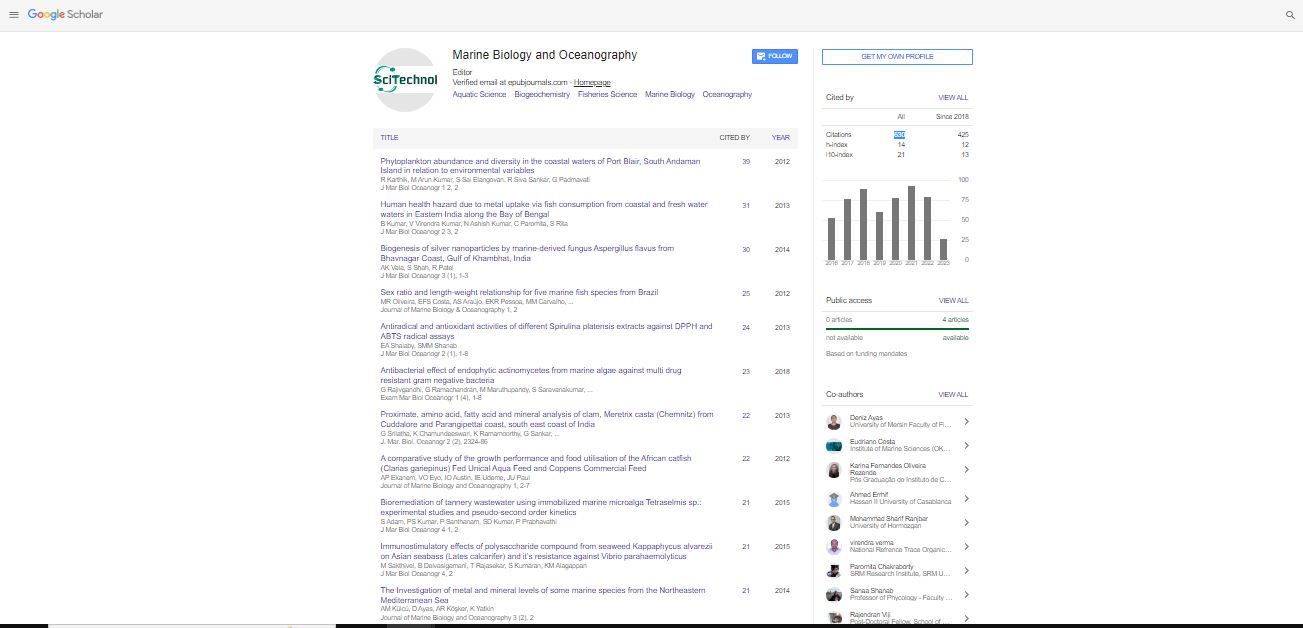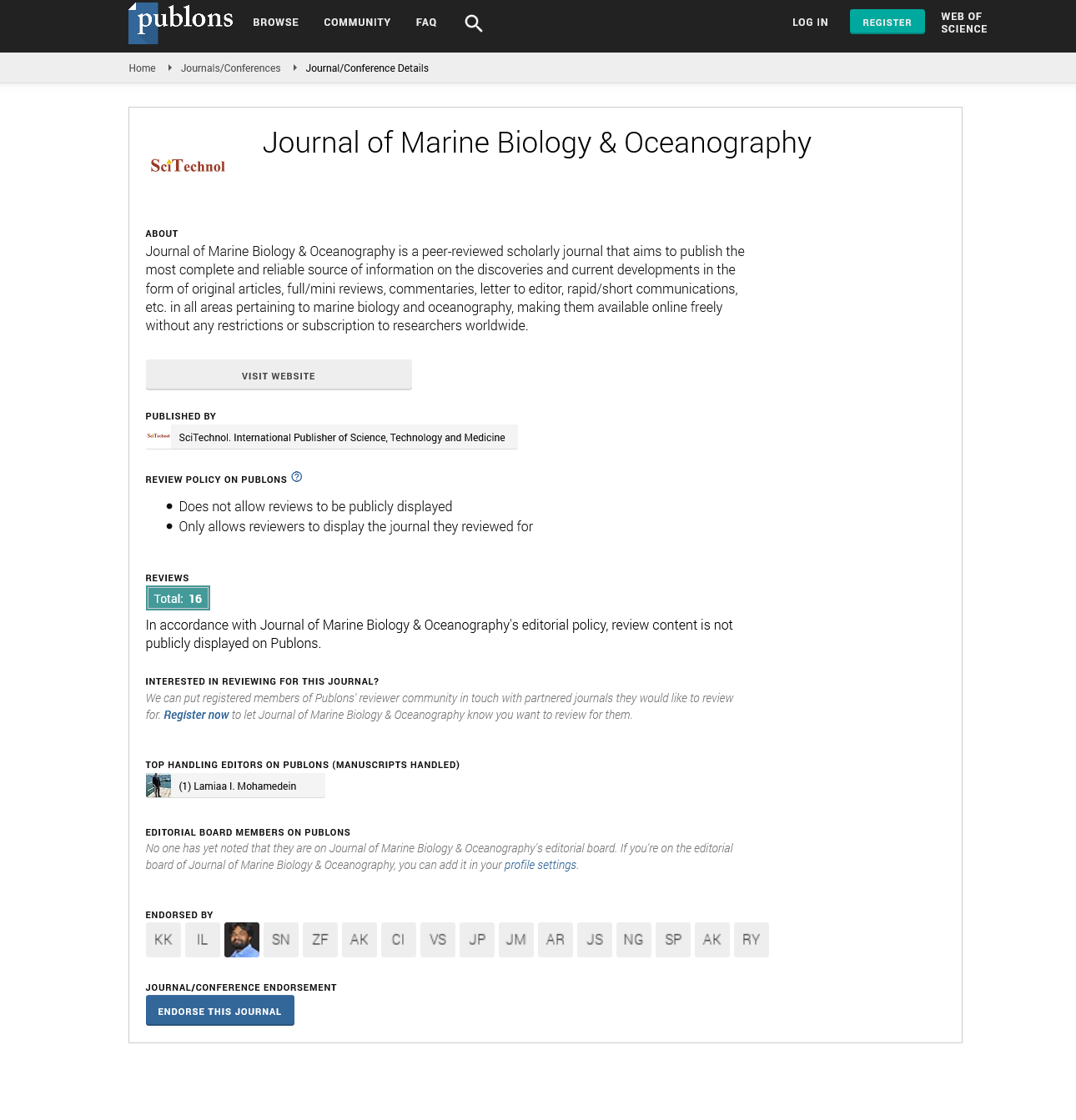Opinion Article, J Mar Biol Oceanogr Vol: 11 Issue: 2
The Relationships between Substrate Properties and the Acoustic Response of the Seafloor
Kaushalendra Mangal Bhatt*
Department of Marine Biology,National Geophysical Research Institute (CSIR-NGRI), Hyderabad, India
*Corresponding author: Kaushalendra Mangal Bhatt, Department of Marine Biology, National Geophysical Research Institute (CSIR-NGRI), Hyderabad, India, Email: mangabk657@gmail.com
Received date: 11 January, 2022, Manuscript No. JMBO-22-57172;
Editor assigned date: 13 January, 2022, Pre QC No. JMBO-22-57172 (PQ);
Reviewed date: 24 January, 2022, QC No JMBO-22-57172;
Revised date: 04 February, 2022, Manuscript No. JMBO-22-57172 (R);
Published date: 21 February, 2022, DOI:10.4172/jmbo.1000229
Keywords: Acoustic Response
Description
Acoustic data collected by Multi Band Echo Sounders (MBES) are increasingly used for high resolution seabed mapping. The relationships between substrate properties and the acoustic response of the seafloor depend on the acoustic angle of incidence and the operating frequency of the sonar, and these dependencies can be analyzed for discrimination of benthic substrates or habitats. An outstanding challenge for angular MBES mapping at a high spatial resolution is discontinuity; acoustic data are seldom represented at a full range of incidence angles across an entire survey area, hindering continuous spatial mapping. Given quantifiable relationships between MBES data at various incidence angles and frequencies, we propose to use multiple imputations to achieve complete estimates of angular MBES data over full survey extents at a high spatial resolution for seabed mapping. The primary goals of this study are to evaluate the effectiveness of multiple imputations for producing accurate estimates of angular backscatter intensity and substrate penetration information, and to evaluate the usefulness of imputed angular data for benthic habitat and substrate mapping at a high spatial resolution. Using a multi-frequency case study, acoustic soundings were first aggregated to homogenous seabed units at a high spatial resolution via image segmentation.
Multiple Imputation by Chained Equations
The effectiveness and limitations of imputation were explored in this context by simulating various amounts of missing angular data, and results suggested that a substantial proportion of missing measurements (> 40%) could be imputed with little error using Multiple Imputation by Chained Equations (MICE). The usefulness of imputed angular data for seabed mapping was then evaluated empirically by using MICE to generate multiple stochastic versions of a dataset with missing angular measurements. The complete, imputed datasets were used to model the distribution of substrate properties observed from ground-truth samples using Random Forest and neural networks. Model results were pooled for continuous spatial prediction and estimates of confidence were derived to reflect uncertainty resulting from multiple imputations. In addition to enabling continuous spatial prediction, the high-resolution imputed angular models performed favorably compared to broader segmentations or non-angular data. The study investigates sea-level measurements observed from 12 tide gauge sites over the Indian coastal area during the last two decades. Initially, the rise of sea-level (slope) and acceleration is estimated by fitting the linear and parabolic equations in the recorded data from tide gauge measurements. The estimated results showed the abrupt change of relative sea-level measurements at the distinct site depends upon the tide gauge site locations. To accurately analyze the regional coastal sea level pattern, the tide gauge time series data are decomposed in sine and cosine functions at different frequencies followed by the spectral analysis. Analysis of the results confirmed that the tide gauges peaks do not occur at the fixed period at each tide gauge site, instead they repeat with varying time periods. The spectrum peaks width fluctuates at distinct sites and the general pattern of frequency spectrum does not follow a unique model. Such type of characteristic variation with the time is possibly because of the effective variables, which affects the steadiness of sea-level changes. The study concludes that the experimental results from the Indian coastal region must be included during the comparison of global data sets and other contemporary oceanic models. In Ocean-Bottom Node (OBN) seismic exploration, a ghost is a common interference wave that affects the accuracy of seismic data interpretation.
Hydrophone and Geophone to Collect Seismic Signals
Receiver de-ghosting can be achieved using dual-sensor summation technology, which employs a hydrophone and geophone to collect seismic signals. The differences between the two receivers cause the polarities of the ghost wave signals to be opposite; therefore, the ghost waves can be eliminated by adding these receivers. However, there are differences between the actual data obtained from the hydrophone and geophone with regard to frequency, phase, and amplitude, thereby preventing them from being directly summated. Therefore, the frequency, phase and amplitude of both data records must be matched for consistency before dual-sensor summation can be conducted. In addition, some noise and ghosts will remain during data processing, resulting in a reduction in the signal-to-noise ratio of the data, making it necessary to adopt noise and residual ghost suppression methods. In this study, a wavelet analysis was newly introduced to the dual-sensor summation process. Specifically, the wavelet spectrum whitening method was proposed for the frequency matching of dual-sensor data, and the nonlinear wavelet transform threshold method of the wavelet de noising method was applied to suppress the noise and residual ghost. On this basis, a new dual-sensor process flow in OBN seismic exploration was developed. The feasibility and effectiveness of the method were verified using actual data. The method proposed in this study will help to improve the accuracy of future data processing. Seismic feature characterization in the time domain remains a challenge for geoscientists, thus motivating transformation to the frequency domain. This study exposes an unreported buildup through a frequency domain transformation of seismic sections using constrained least squares spectral analysis for spectral decomposition. The imaged buildup appears at an anomalous low frequency of 5 Hz and vanishes at frequencies higher than 10 Hz and is traced in time domain. The geological context and feature morphology suggest that the buildup seems to be a reef. Further, quantitative scoring using regional, geophysical and geological criteria suggest a possible isolated carbonate buildup. This suggests a future exploration prospect and opens the scope for further geophysical investigation, developing conceptual models and practical evaluation.
 Spanish
Spanish  Chinese
Chinese  Russian
Russian  German
German  French
French  Japanese
Japanese  Portuguese
Portuguese  Hindi
Hindi 
